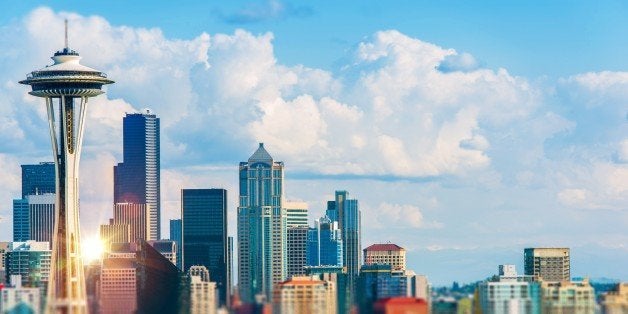
Recent victories in the states of New York and California to raise the minimum wage for workers in those states should be hailed as victories for a resurgent progressive politics that is affecting both sides of the aisle in the presidential contest. But these victories at the state level came after cities led the way on raising the minimum wage, from Seattle, San Francisco and Los Angeles to Portland, Maine; Santa Fe, New Mexico; and Louisville, Kentucky. Cities have forged the path forward for raising the minimum wage, with states now looking to follow behind them.
Such experimentation, at the local and state level, advances small change to bring about big change. We saw this in the marriage equality movement, as local and state initiatives to promote LGBT rights slowly, over decades, led to landmark decisions out of the U.S. Supreme Court. In an earlier era, minimum wage experimentation at the local and state level led to not just change at the Supreme Court, but national initiatives that turned out to be the cornerstones of the New Deal. Initially, the Supreme Court froze progressive policy and legislation. The Court later succumbed to political realities made possible by aggressive experimentation at the state and local level.
Today, while the Supreme Court is deadlocked, Washington paralyzed, and many state legislatures in the clutches of regressive politicians, it is at the local level where effective policies have the best chance for success. Moreover, by pressing for such measures, measures that a majority of Americans support in many instances, like raising the minimum wage and bringing about criminal justice reform, the results of such efforts may break some of the logjam in Washington and the states. They may bring about desperately needed reform to address economic inequality, climate change, and wage justice.
The idea that the political reality in Washington, DC, may stand as a barrier to what may be termed progressive reform in the US is not new. In fact, it is as old as progressive reform itself. Local experimentation that pushes the outer boundaries of what may seem possible politically, and even pushes beyond those boundaries, was essential to the adoption of a federal minimum wage standard, and even led to broader, progressive policy goals. It suggests that local experimentation today might blaze a similar path forward, despite what might appear as unwavering political opposition.
Around the turn of the late 19th to the 20th century, progressive advocates pressed states to experiment with setting a minimum hourly wage. Initially, Massachusetts led the way, authorizing a state wage board to suggest a minimum wage for women and children, but it was not mandatory. By 1920, 13 states were experimenting with different approaches: empowering wage boards like in Massachusetts, setting wages based on what was perceived to be an ability of employers to pay them, or passing the types of broad minimum wage requirements we see today.
The legal question of whether a governmental authority could set a minimum wage first came before the Supreme Court when employers challenged a local ordinance that applied only to the nation's capital, one that had been passed by Congress to set a minimum wage for women and children. It authorized a local wage board to "ascertain and declare...[s]tandards of minimum wages for women in any occupation within the District of Columbia, and what wages are inadequate to supply the necessary cost of living to any such women workers to maintain them in good health and to protect their morals." With minors, the board was directed to assess "standards of minimum wages for minors in any occupation within the District of Columbia, and what wages are unreasonably low for any such minor workers." In the case, Adkins v. Children's Hospital, the Supreme Court struck down this legislation under the so-called "freedom to contract," a doctrine the conservative Supreme Court at the time had used to invalidate progressive attempts to make the laissez-faire economy of the early 20th century more receptive to policies to protect workers and consumers.
Despite the court's ruling in Adkins, dozens of states continued to adopt their own minimum wage laws. In 1936, the Court took up a challenge to New York's law and invalidated it, endorsing the previous ruling in Adkins. Just ten months later, however, the Supreme Court revisited the issue and switched its position, holding that Washington State's minimum wage law was constitutional. It would disavow the doctrine of freedom of contract that had held up progressive efforts and ultimately clear the way for broad and sweeping New Deal legislation, bringing about changes that would affect generations of Americans. Indeed, once the Court approved minimum wage laws, Congress passed the Fair Labor Standards Act that set a federal minimum wage and endorsed other New Deal programs. It also opened the door to further state and local government experimentation in the minimum wage field that goes beyond what the federal law authorizes.
Some debate the extent to which the political climate created by Roosevelt's proposed plan to increase the size of the Court ultimately led to the "switch in time that saved nine," the vote of one justice to change his mind on the minimum wage laws and open the door to progressive reform. At the same time, if states had not pressed the issue, and promoted minimum wage laws even in the face of the Supreme Court's apparent rejection of them, the opportunity would never have arisen for the political tide to shift and the Court to change its view of such legislation.
Political realities in the federal government and some states may discourage advocates from pushing for progressive reforms today. But experimentation at the level of cities on the minimum wage and other issues, which may create opportunities presently unforeseen, and unpredictable shifts in alliances like what happened in the 1930s, may hold the key to future successes of what appears to be a slowly strengthening progressive movement. Because of this, advocates within the movement would push wherever possible for desired reforms: especially at the local level, where the environment might be more favorably inclined toward progressive ideas. Those ideas can then filter up, creating opportunities at the level of state governments, and maybe creating openings for broader, national change. If the history of the minimum wage in this country is any guide, such bold experimentation, where possible, can lead to change that is unforeseen, unpredictable, and uncontrollable.
It is these sorts of efforts--local, progressive, creative, pragmatic--that are explored in a new work that looks at the minimum wage fight and other efforts as examples of where cities can step in despite paralysis in other levels of government. Cities can take the lead to devise and implement solutions to some of the thorniest problems facing the planet today. They can address dramatic shifts in populations, like with contracting cities such as Detroit, or ever growing cities, like New York; can face climate change's threat; and can combat economic inequality. They are in a position to sidestep partisan bickering and take common-sense steps to address hard-to-tackle problems. A new work, How Cities Will Save the World: Urban Innovation in the Face of Population Flows, Climate Change, and Economic Inequality, explores these issues. For an overview of the book, read its Introduction, which is available here.
